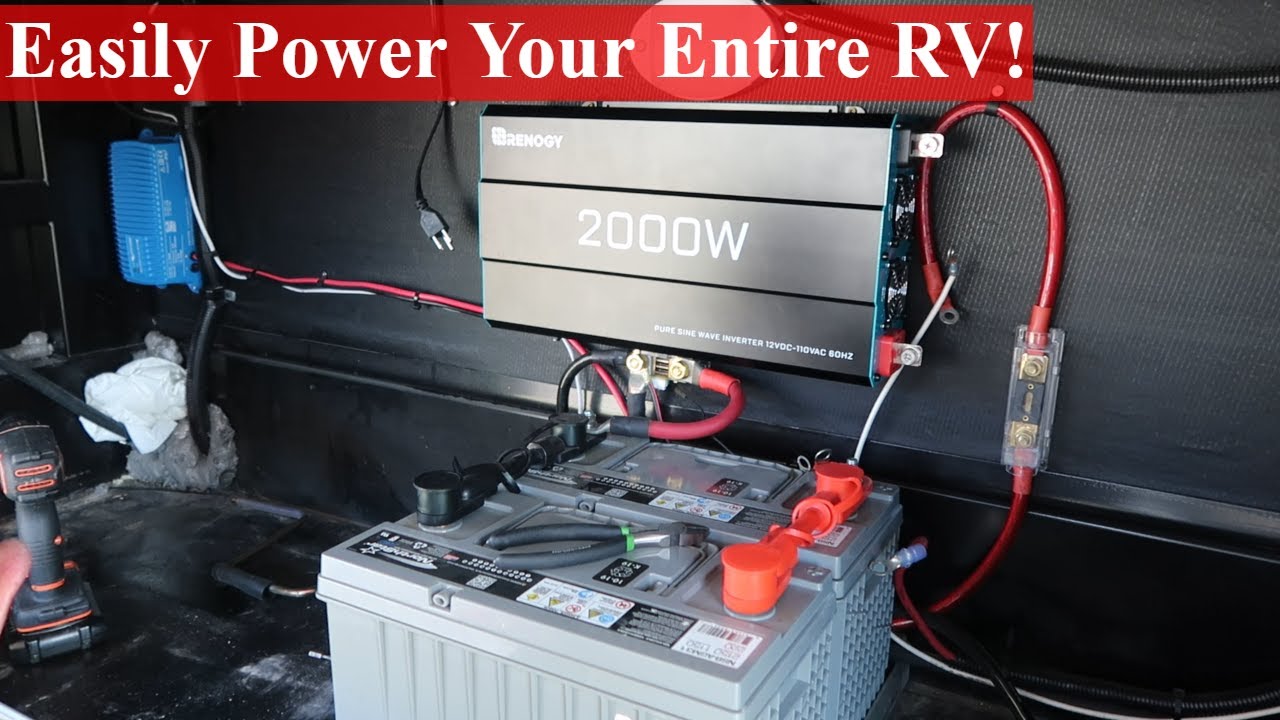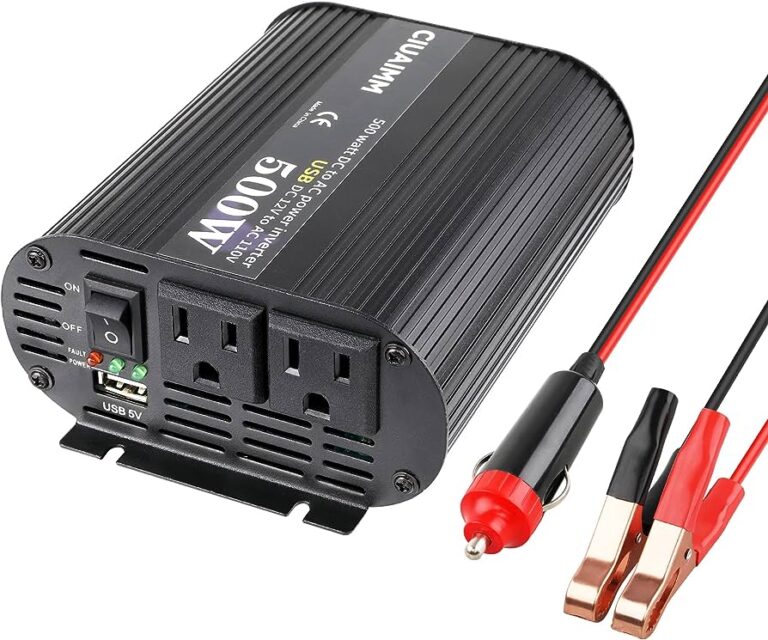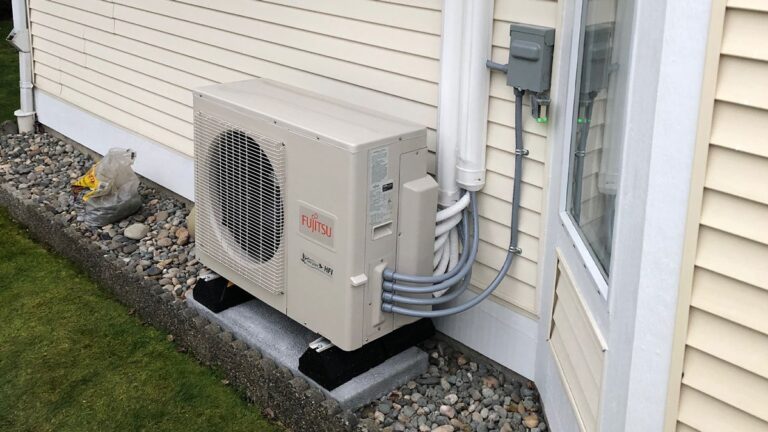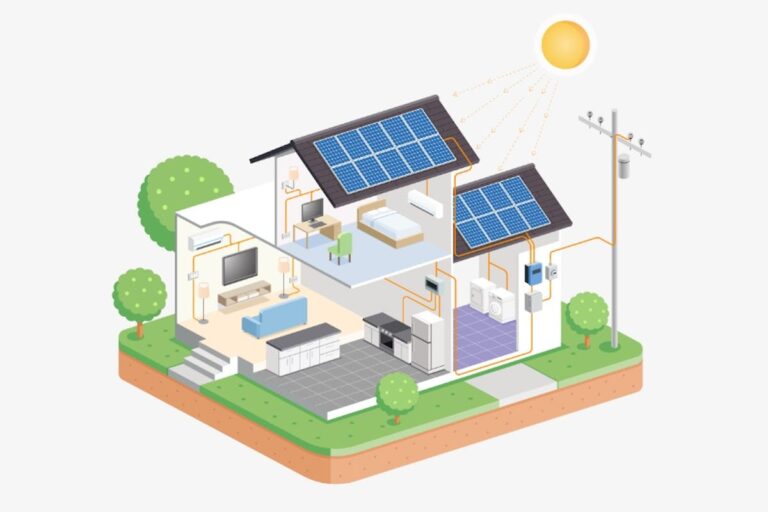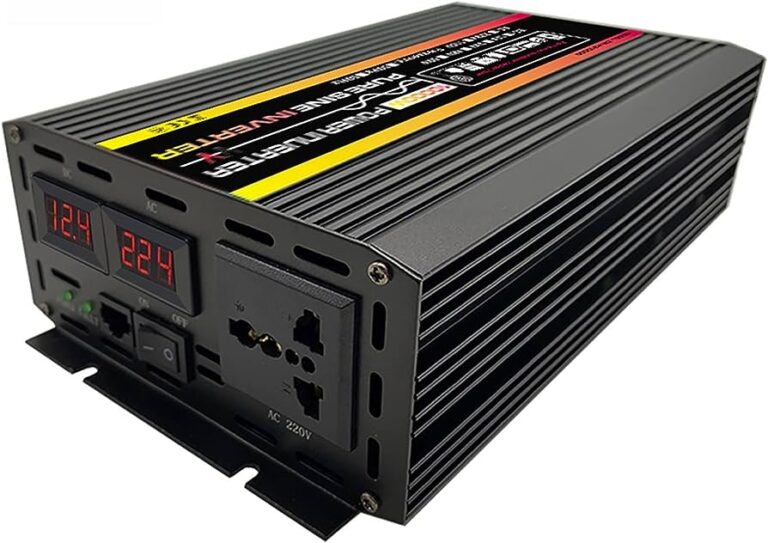What Does an Inverter Do in an Rv
An RV inverter converts DC power from the battery into AC power for your RV’s power outlets, allowing you to power appliances and devices that require AC power. RV inverters make the different types of power compatible between the battery and appliances.
RVs, or recreational vehicles, provide a great way to travel and experience the outdoors while enjoying the comforts of home. These vehicles come equipped with various systems to ensure a convenient and enjoyable experience on the road. One important component of an RV is the inverter.
But what does an inverter do in an RV? We will explore the role of an inverter in an RV, how it works, and why it is essential for powering appliances and devices while on the move. Whether you’re a seasoned RV enthusiast or new to the world of RVing, understanding the function of an inverter is crucial for a smooth and comfortable journey. So, let’s dive in and discover the ins and outs of an RV inverter.
Understanding The Basics
An RV inverter is responsible for converting DC power from the battery into AC power, allowing you to power your appliances and outlets while off-grid. It ensures compatibility between the different power types, making it essential for a functioning RV electrical system.
Definition Of An Inverter In Rvs
An inverter is an essential component of an RV’s electrical system that allows you to use household appliances and electronic devices while on the road. It converts DC (direct current) power from your RV’s battery into AC (alternating current) power, which is what most appliances require.
This enables you to enjoy the comforts and conveniences of home even when you’re off-grid.
Comparison Of Ac And Dc Current
To understand how an inverter works, it’s important to know the difference between AC and DC current:
- AC (alternating current): This is the type of electricity that powers most appliances and electronics in your RV. AC current flows in a back-and-forth motion, constantly changing direction. It is the type of power supplied by electrical grids and typically used in homes.
- DC (direct current): DC current flows in a single direction and is commonly produced by batteries and solar panels. Many RVs have a DC electrical system that powers lights, fans, and other basic functions.
How Inverters Convert Dc To Ac Power
Inverters play a crucial role in converting DC power from your RV’s battery into AC power that can be used by appliances. Here’s how they accomplish this:
- Inverter Input: The inverter takes in DC power from your RV’s battery.
- Inverter Circuitry: The inverter’s circuitry includes electronic components that convert the DC power into a high-frequency AC signal.
- Transformer: The AC signal is then transformed into a usable AC voltage through a transformer within the inverter.
- Waveform: Inverters produce a modified sine wave or a pure sine wave. The type of waveform affects the quality and compatibility of the power output.
- Power Output: The converted AC power is then distributed through the inverter’s outlets or wired directly to specific appliances.
Inverters in RVs are crucial for converting DC power from batteries into AC power that is compatible with most appliances. They allow you to enjoy the comforts of home, even when you’re miles away from electrical hookups.
Now that we have a basic understanding of what an inverter does in an RV, let’s explore why you might need one and some installation tips and best practices.
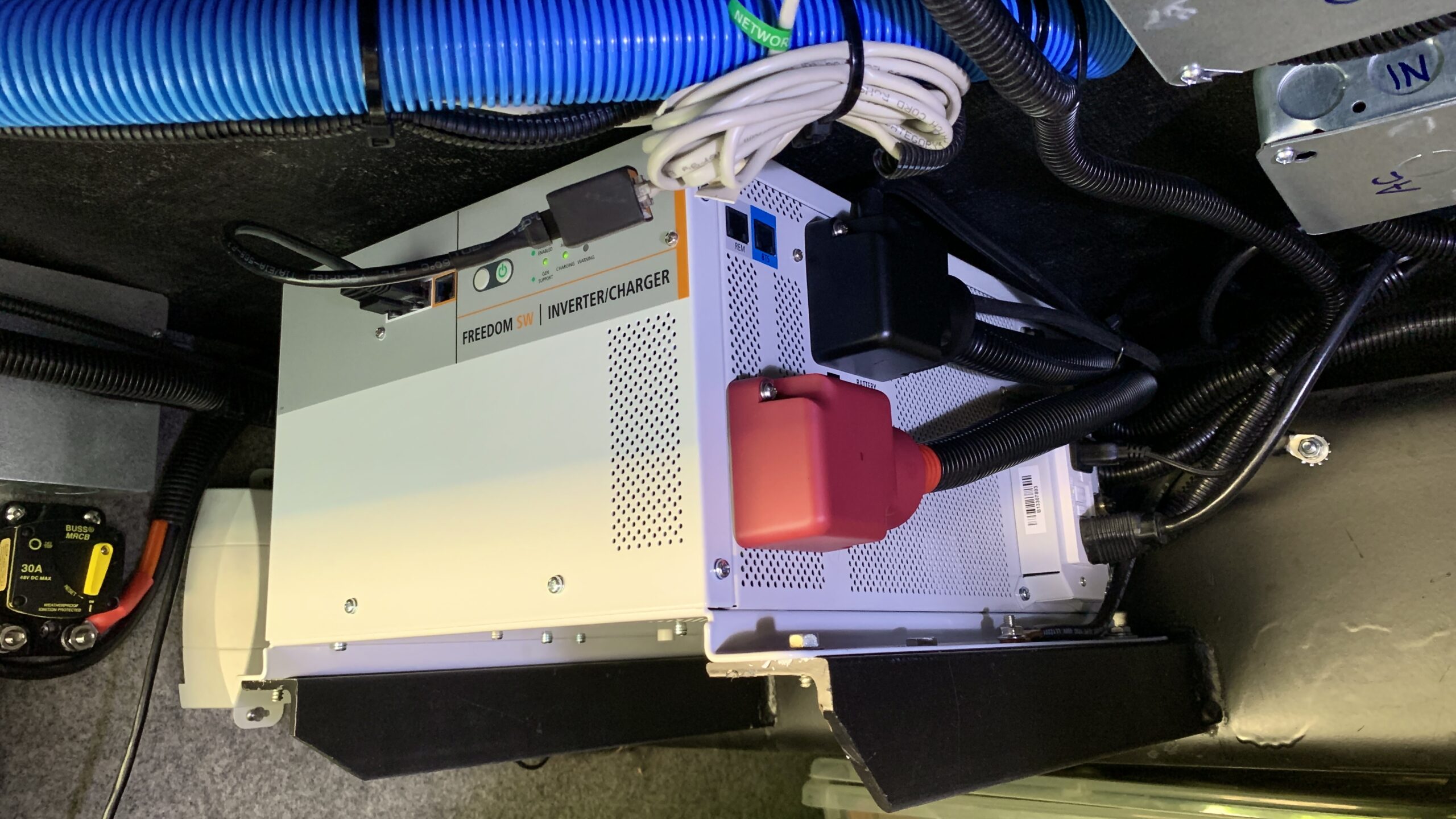
Credit: www.thervgeeks.com
Inverter Vs. Converter: Key Differences
An RV inverter plays a key role in providing power to your RV’s outlets by making DC power from the battery compatible with AC amperage used by most appliances. It acts as a converter, ensuring the right type of power is supplied.
Differentiating Between Inverters And Converters:
- Inverters and converters are both vital components of an RV power system, but they serve different purposes.
- An inverter converts DC (direct current) power from the RV’s batteries into AC (alternating current) power for running appliances and devices.
- A converter, on the other hand, converts AC power from an external source (such as a campground hookup or generator) into DC power to charge the RV’s batteries.
Function Of Converters In Rvs:
- Converters play a crucial role in RVs by ensuring the batteries stay charged and supplying DC power to the RV’s electrical system.
- When the RV is connected to an external AC power source, the converter charges the batteries and provides power to run lights, water pumps, and other DC-powered devices.
- The converter also prevents overcharging of the batteries by regulating the voltage and current flowing into them.
Exploring The Role Of Inverters In Rv Power Systems:
- Inverters are essential for RVs that need AC power when they are not connected to an external source.
- They convert the DC power stored in the batteries into AC power, allowing you to use appliances and devices that require AC power, such as TVs, microwaves, and laptops.
- Inverters come in different sizes and power outputs, so you can choose one that meets your specific energy needs.
- They provide a convenient way to power your RV’s devices and appliances while you are on the road or boondocking in remote locations.
- With an inverter, you can enjoy the comforts of home even when you are off-grid.
Why Do You Need An Inverter?
An inverter is essential in an RV because it converts DC power from the battery to AC power, allowing you to power appliances and devices that require AC electricity. It ensures compatibility between the battery’s DC power and the standard AC amperage used by most appliances.
Benefits Of Having An Inverter In An Rv:
An inverter is an essential component for RV owners, providing numerous benefits that enhance their overall camping experience. Let’s explore why you need an inverter in your RV:
- Providing power for AC appliances on the go: With an inverter installed in your RV, you can power various AC appliances, such as televisions, microwaves, and air conditioners, even when you are not connected to a shore power source. This means you can enjoy the convenience of these appliances while on the road or camping in remote locations.
- Charging electronic devices while camping: In today’s digital age, electronic devices have become a crucial part of our lives. An inverter allows you to charge your electronic devices, including smartphones, tablets, laptops, and cameras, while you are camping. This ensures that you stay connected, capture memorable moments, and can use your devices whenever you need them.
- Flexible power options: Having an inverter in your RV gives you the flexibility to choose different power options. Whether you want to rely on the RV’s batteries or connect to external power sources like solar panels or generators, the inverter seamlessly converts the DC power stored in your RV’s batteries into AC power, providing you with a continuous and reliable power supply.
- Peace of mind during power outages: In the case of power outages at campsites or during an emergency situation, an inverter acts as a backup power source. It ensures that you have access to essential appliances and devices, providing peace of mind and allowing you to continue your activities without interruption.
- Convenience and comfort: An inverter adds an extra level of convenience and comfort to your RV camping experience. You can watch your favorite TV shows or movies, prepare meals in a microwave, or use your air conditioner to regulate the temperature inside your RV, all without relying solely on external power sources.
- Increased independence: With an inverter, you have the freedom to camp in locations that do not have access to electrical hookups. You can explore off-grid camping and still enjoy the comforts of home by using your RV’s inverter to power your appliances and devices.
- Energy efficiency: Inverters are designed to be energy efficient, minimizing power wastage and maximizing the usage of your RV’s batteries. They regulate the conversion process, ensuring that the power is used efficiently and effectively, giving you the most out of your available power supply.
- Cost savings: In the long run, having an inverter in your RV can lead to cost savings. Instead of relying heavily on external power sources or constantly running noisy generators, an inverter allows you to utilize your RV’s batteries and other alternative power sources, reducing fuel and maintenance costs.
- Environmental friendliness: By using an inverter in your RV, you contribute to a cleaner and greener environment. The reduced reliance on generators and other fossil fuel-based power sources helps to minimize carbon emissions and promote eco-friendly camping practices.
- Enhanced camping experience: Overall, an inverter enhances your RV camping experience by providing the convenience, flexibility, and peace of mind you need to fully enjoy your time on the road. It allows you to stay connected, powered up, and comfortable, transforming your RV into a self-sufficient and comfortable living space wherever you go.
With the numerous benefits it offers, an inverter is undoubtedly a valuable addition to any RV. Whether you’re a weekend camper or a full-time RVer, having an inverter ensures that you have reliable power for your appliances and devices, making your camping experience more enjoyable and convenient.
Considerations For Inverter Installation
When installing an inverter in an RV, it’s important to consider how it works and what it does. Inverters convert DC power from the RV’s battery to AC power, allowing appliances to run smoothly. Ensuring compatibility between the two types of power is crucial for proper installation.
Installing an inverter in your RV can greatly enhance your camping experience by providing you with the ability to power up your appliances and devices even when you’re off the grid. However, there are a few important considerations you need to keep in mind when installing an inverter in your RV.
From proper wiring and circuitry setup to choosing the right size and type of inverter, here are some tips to ensure a successful installation:
Tips For Installing An Inverter In An Rv:
- Proper wiring and circuitry setup:
- Ensure that your RV’s electrical system is capable of handling the additional load that the inverter will introduce.
- Use appropriate gauge wires to connect the inverter to the batteries and ensure that they are properly secured.
- Install proper fuses or circuit breakers to protect your RV’s electrical system in case of any overloads or short circuits.
- Consider hiring a professional electrician who is experienced in RV electrical systems to assist with the installation.
- Choosing the right size and type of inverter:
- Determine your power requirements by making a list of all the appliances and devices you plan to power with the inverter.
- Calculate the total power consumption of these appliances and devices to determine the wattage rating of the inverter you need.
- Consider the type of inverter that suits your needs. Pure sine wave inverters are more expensive but provide a cleaner and more stable power output, while modified sine wave inverters are more affordable but may not be suitable for sensitive electronics.
- Take into account any future power needs and potential expansion when choosing the size and type of inverter.
Remember, proper installation and maintenance of your inverter are crucial for its optimal performance and longevity. Ensure that you follow the manufacturer’s instructions and consult with professionals if needed. By considering these tips, you can confidently install an inverter in your RV and enjoy the convenience of off-grid power during your camping adventures.
Essential Rv Loads For Inverter Power
An RV inverter is responsible for converting DC power from the battery into AC power to run appliances through the power outlets in the RV. It ensures compatibility between the two types of power and allows for the use of electronic devices on the go.
In an RV, an inverter is a crucial component that converts DC (direct current) power stored in batteries into AC (alternating current) power to run various electrical appliances. To make the most out of your RV’s inverter setup, it’s important to identify the essential loads that can be powered by an inverter.
Below are some common RV appliances that can be powered using an inverter:
- Lights: Interior and exterior lights in your RV can be powered by an inverter. LED lights are particularly energy-efficient and can help conserve battery power.
- Television and Entertainment Systems: You can enjoy your favorite shows and movies while on the road by using an inverter to power your TV, DVD player, and gaming consoles.
- Refrigerator: Keeping your food fresh and cold is essential during your RV adventures. An inverter can power your refrigerator, ensuring that your groceries stay fresh while on the move.
- Microwave: Need to quickly heat up your leftovers or make a cup of tea? With an inverter, you can power your microwave oven and enjoy the convenience of hot meals on the go.
- Coffee Maker: For all the coffee lovers out there, an inverter can power your coffee maker, allowing you to enjoy a freshly brewed cup of joe anytime, anywhere.
- Electric Stove: If your RV has an electric stove, using an inverter can enable you to cook your favorite meals without the need for a generator or shore power.
- Charging Devices: In today’s digital age, keeping your devices charged is essential. An inverter can power your smartphones, tablets, laptops, and other electronic devices, ensuring that you stay connected even on the road.
Recommended Power Load For Different Components
To ensure optimum performance and efficiency of your inverter setup, it’s important to understand the recommended power loads for different components. Here are some general guidelines:
- Refrigerator: RV refrigerators typically consume around 150-200 watts of power when running. However, during the startup phase, they may require additional power. It’s recommended to use an inverter with a power capacity that can handle the startup surge.
- Microwave: Microwaves come in different wattages, ranging from 600 to 1500 watts. When choosing an inverter, make sure it can handle the peak power requirement of your microwave.
- Coffee Maker: Coffee makers usually consume around 600-1200 watts of power. Consider the power requirements of your specific coffee maker when selecting an inverter.
- Electric Stove: Electric stoves can consume a significant amount of power, ranging from 1000 to 3500 watts or more. It’s crucial to choose an inverter that can handle the power demands of your stove.
Maximizing Energy Efficiency With An Inverter Setup
To make the most out of your inverter setup and maximize energy efficiency, consider the following tips:
- Choose an Energy-Efficient Inverter: Opt for a high-quality inverter with a high efficiency rating. This will ensure that less power is wasted during the conversion process, resulting in more efficient power usage.
- Use Energy-Efficient Appliances: Energy-efficient appliances, such as LED lights and low-power-consumption electronics, can significantly reduce the overall power demands on your inverter setup.
- Manage Power Consumption: Be mindful of your power usage and prioritize essential appliances. Turn off or unplug any non-essential devices to conserve energy and extend the battery life.
- Monitor Battery Levels: Keep an eye on your battery levels to avoid completely draining them. Consider investing in a battery monitor, which can provide real-time information on your battery’s health and capacity.
- Consider Solar Power: Adding solar panels to your RV can supplement your inverter setup and help recharge your batteries, especially during sunny days. This can reduce the reliance on your inverter and extend your power supply.
By identifying the essential loads that can be powered by an inverter, understanding the recommended power loads for different components, and maximizing energy efficiency, you can fully harness the benefits of an inverter in your RV. So, go ahead and enjoy the comforts of home on your RV adventures with the help of a reliable inverter setup.
Best Practices For Using An Inverter In An Rv
RV inverters play a crucial role in converting the DC power from your RV’s battery into AC power compatible with your appliances. They ensure that all your power outlets receive the appropriate type of power, making it possible to run various appliances and devices in your RV.
In order to optimize the performance of an inverter in your RV, it’s important to follow some best practices. Here are some tips to help you get the most out of your RV inverter:
- Choose the right size inverter for your needs: Before purchasing an inverter, consider the power requirements of your RV appliances and electronics. Make sure to choose an inverter of the appropriate size to handle the load.
- Use pure sine wave inverters: Pure sine wave inverters produce high-quality electricity that is compatible with all types of appliances and electronics. They are more expensive than modified sine wave inverters, but offer better performance and reduced risk of damage to your devices.
- Install the inverter close to the battery: To minimize power loss and voltage drop, install the inverter as close to your RV battery as possible. This will ensure efficient power distribution and reduce the risk of electrical issues.
- Use the right cables and wiring: Use appropriate cables and wiring to connect your inverter to the battery and the RV’s electrical system. Poor-quality or undersized cables can result in power loss and decreased inverter performance. Ensure that the cables are securely connected and properly insulated.
- Proper ventilation for the inverter: Inverters generate heat during operation, so it’s essential to provide adequate ventilation to prevent overheating. Make sure the inverter is installed in a well-ventilated area to maintain optimal performance and avoid potential damage.
- Avoid running high-power appliances simultaneously: Running multiple high-power appliances at the same time can overload your inverter and drain the battery quickly. To avoid this, stagger the use of power-hungry devices and prioritize their usage to ensure optimal power distribution.
Maintenance And Troubleshooting Of Inverters
Regular maintenance and troubleshooting of your RV inverter can help prolong its lifespan and ensure reliable performance. Here are some maintenance tips and troubleshooting steps to keep in mind:
- Inspect and clean the inverter regularly: Check the inverter for any signs of dust, dirt, or debris accumulation. Clean the exterior and the ventilation areas to maintain good airflow and prevent overheating. Ensure that all connections are secure and free from corrosion.
- Monitor battery levels: Keep an eye on your RV battery levels to ensure they are adequately charged. Low battery levels can affect the performance of your inverter. Consider installing a battery monitor to accurately track the battery’s state of charge.
- Check for error codes or indicators: Inverters often have built-in error codes or indicators to alert you to any issues or malfunctions. Refer to the manufacturer’s manual to understand what these codes mean and take appropriate action if you encounter any problems.
- Address electrical issues promptly: If you experience any electrical issues in your RV, such as flickering lights or power surges, it’s crucial to address them promptly. These issues can be indicative of problems with the inverter or other electrical components, and ignoring them may lead to further damage.
Safety Precautions For Using Inverters In Rvs
While inverters can enhance your RV experience, it’s essential to follow safety precautions to ensure a safe and secure environment. Here are some safety tips to consider:
- Turn off the inverter when not in use: When you’re not actively using the inverter, it’s a good practice to turn it off. This helps conserve battery power and reduces the risk of electrical issues or accidental activation.
- Use surge protectors: Invest in surge protectors to safeguard your RV appliances and electronics from power surges. Inverter-generated power can sometimes have fluctuations that may damage sensitive devices, and using surge protectors can provide an extra layer of protection.
- Follow manufacturer’s instructions: Always refer to the manufacturer’s instructions and guidelines specific to your RV inverter. This ensures that you are operating the inverter correctly and safely, and helps avoid any unforeseen complications.
- Keep flammable materials away: Inverters generate heat during operation, so it’s crucial to keep flammable materials away from the inverter and its surrounding area. This reduces the risk of fire hazards and ensures a safer RV environment.
- Regularly check for loose connections or damaged cables: Periodically inspect the inverter connections and wiring for any signs of damage or loose connections. Address any issues promptly to prevent safety hazards and maintain the integrity of your RV’s electrical system.
By following these best practices and safety precautions, you can optimize the performance of your RV inverter, ensure its longevity, and create a safe and enjoyable RVing experience.
How Does a DC to AC Converter Work in an RV Inverter?
A DC to AC converter, commonly known as an inverter, plays a crucial role in mastering power conversion within RVs. This device seamlessly transforms the direct current (DC) from the RV’s battery into alternating current (AC) that powers various appliances. Through its intricate circuitry, the converter ensures a stable power supply, enabling RV owners to enjoy the comforts of home while on the road.
Frequently Asked Questions For What Does An Inverter Do In An Rv
Why Does An Rv Need An Inverter?
An RV needs an inverter because it converts DC power from the battery to AC power for the appliances. RVs typically operate on DC power from the battery, while most appliances require AC power. The inverter bridges the gap between the two, allowing you to use AC-powered devices in your RV.
Should I Leave My Rv Inverter On All The Time?
It is not necessary to leave your RV inverter on all the time. An RV inverter converts DC power from the batteries into AC power to run appliances and devices. However, leaving it on unnecessarily can drain the batteries and reduce their lifespan.
It is advisable to turn off the inverter when not in use or when using campground hookups or a generator. This will help conserve battery power and ensure they are available when needed. Remember to turn off the inverter before starting the engine or connecting to shore power.
Taking these precautions will help optimize the performance and longevity of your RV’s electrical system.
Can I Use My Rv Without An Inverter?
Yes, you can use your RV without an inverter. However, an inverter is useful for converting DC power from your RV’s battery into AC power for your appliances. RVs typically come equipped with a converter, which converts AC power from a campground or generator into DC power to charge the RV’s battery.
But if you want to power your appliances directly from the battery, an inverter is necessary. It ensures that the power from the battery is compatible with the AC appliances in your RV. So, while you can use your RV without an inverter, having one allows you to use your appliances even when you’re not connected to shore power or running a generator.
What Runs Off Rv Inverter?
An RV inverter is responsible for converting DC power from the RV’s battery into AC power to run various appliances and devices. It ensures compatibility between the battery’s DC power and the AC power required by most appliances. In other words, the inverter allows you to use regular household appliances and electronics that run on AC power while relying on the RV’s battery.
This is important because batteries operate on DC power, which is different from the AC power used by most appliances. So, the inverter bridges the gap and ensures that you have the power you need to run your devices while on the road.
Conclusion
An inverter plays a crucial role in an RV by converting DC power from the battery to AC power that can be used to operate appliances and electronics. This is important because most appliances and devices in an RV run on AC power, while batteries provide DC power.
The inverter bridges this gap and ensures compatibility between the two power types, allowing you to enjoy the comforts of home while on the road. By understanding what an inverter does and why it is necessary in an RV, you can make informed decisions about the type and size of inverter you need for your specific power requirements.
Whether you’re running small appliances or powering a full-sized refrigerator, an inverter is essential to keep your RV functioning optimally. So, make sure to choose the right inverter that meets your power needs, and enjoy the convenience and flexibility it brings to your RV adventures.
Happy travels!

